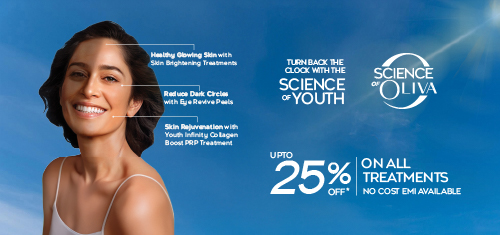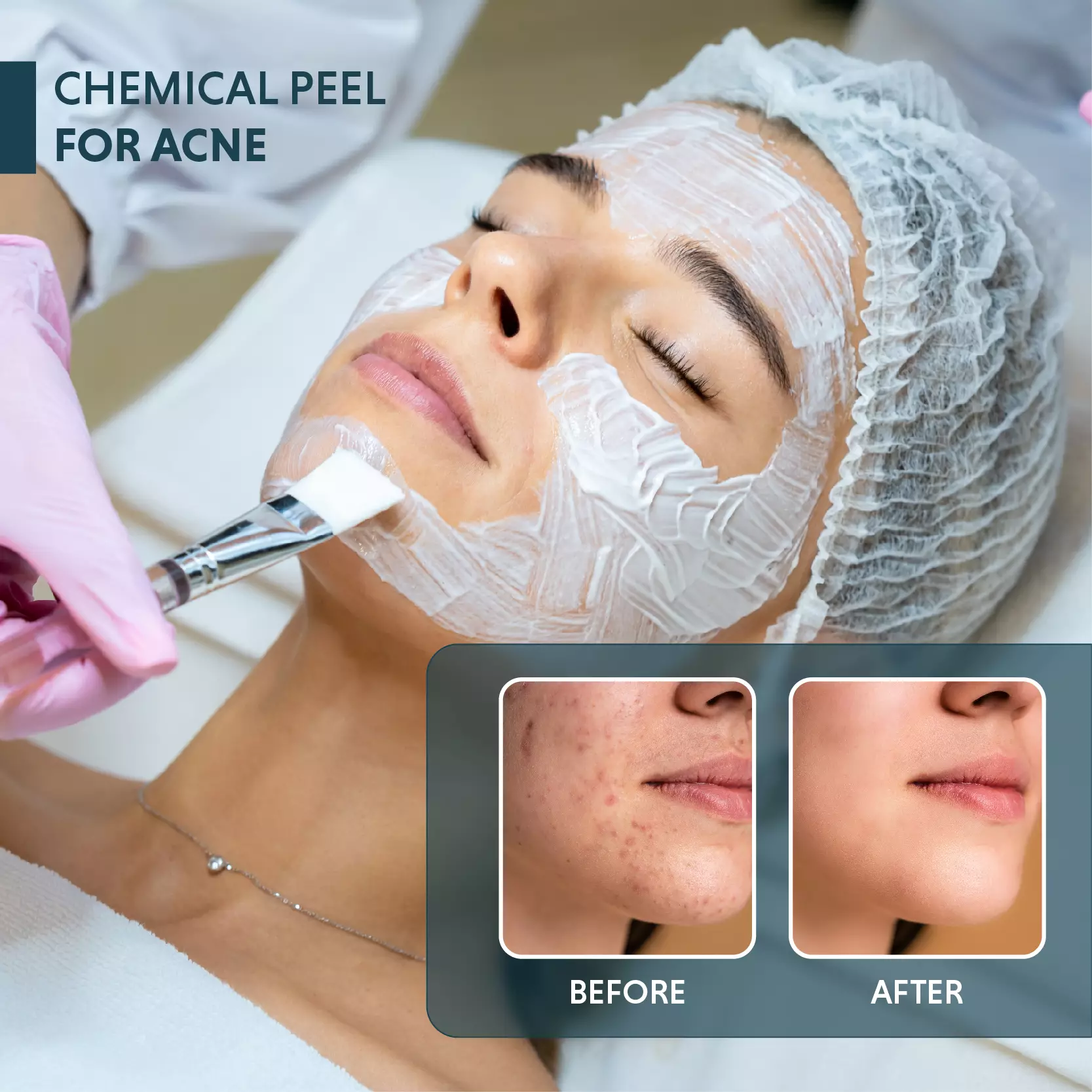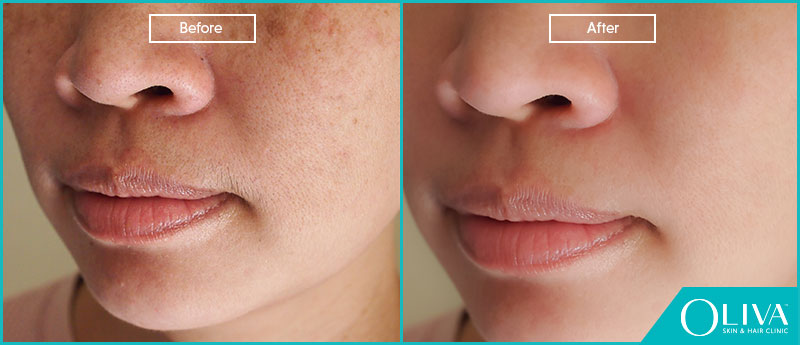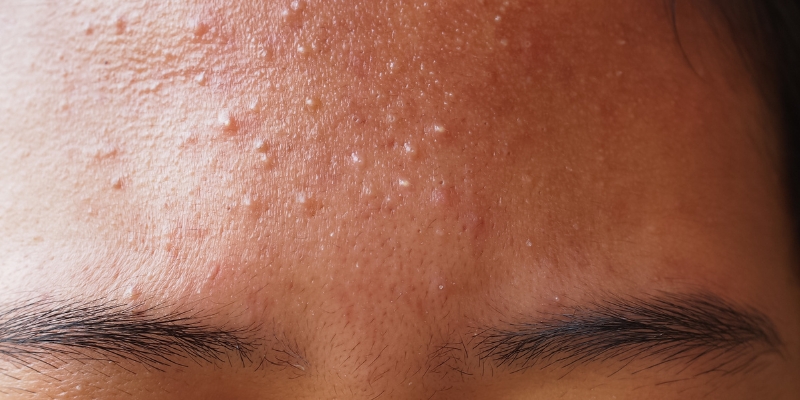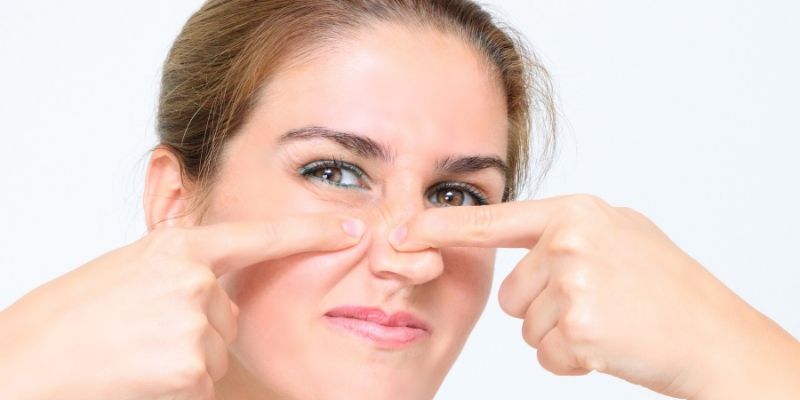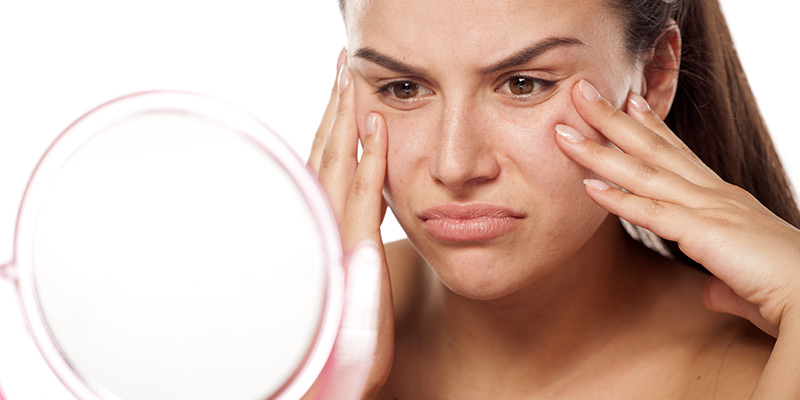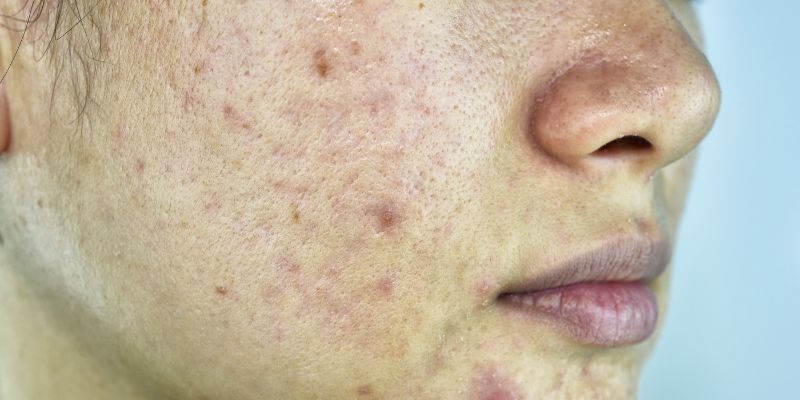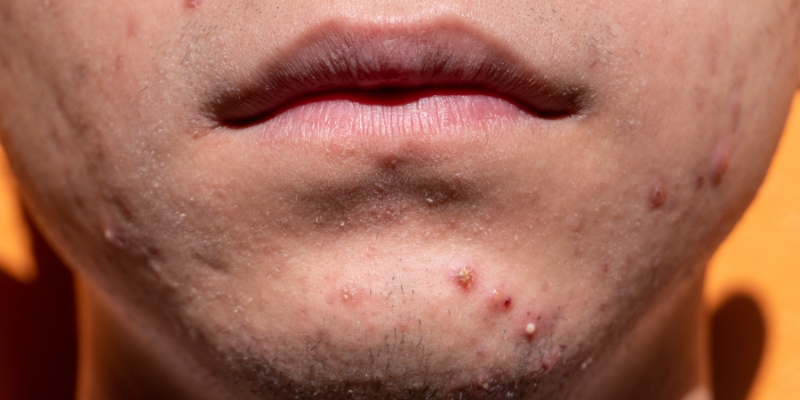Chemical Peels For Acne: How It Works, Types, Benefits & Side Effects
Our skin has thousands of tiny hair follicles in each body part. Acne develops when oils, dead skin cells, and bacteria clog these hair follicles. It can appear in the form of pimples, blackheads, and whiteheads. Chemical peel treatment for acne is a widely used and trusted procedure in dermatological science. The treatment works by addressing factors contributing to acne, such as excess sebum, dead skin cells and dirt, while also preventing bacterial growth. In this article, we will share detailed insights about chemical peel treatment for acne, its benefits, risks and the procedure.
Highlights
- Acne is one of the most prevalent skin conditions affecting men and women across all age groups.
- Clinical studies reveal that around 85% of individuals between the ages of 12 and 24 experience acne due to various reasons.[1]
- While commonly associated with adolescence, acne also affects adults. According to research, over 25% of women and 12% of men in their 40s report struggling with this skin condition.[2]
What Are Chemical Peels? How Do They Work?
Chemical peels are chemical solutions of varying concentrations and acids used to exfoliate and remove the top layer of the skin. This process helps absorb excess oil, eliminates dirt and dead skin cells and fights and controls infections. The treatment reveals youthful, healthier skin underneath the damaged layer. Chemical peels are ideal for reducing acne, and minimising fine lines, wrinkles, scars, uneven skin tone and other imperfections.
How Can Chemical Peels Help With Acne?
Chemical peel application is an optimal solution for treating mild to moderate acne. This is how the treatment helps:
- Exfoliation: Chemical peels involve applying a chemical solution to exfoliate the skin on the targeted area and treat pores clogged or trapped with dirt and dead skin cells.
- Reduced oil production: Chemical peels regulate excess oil production from sebaceous glands, reducing current acne and helping prevent future breakouts.
- Improved cell turnover: Chemical peels stimulate the growth of newer and healthier skin cells by peeling the top damaged layer of skin.
Types Of Chemical Peels For Acne
Here is a quick guide on various types of chemical peels for acne and their benefits:
-
Glycolic Acid Peel:
According to a study, 50% to 95% of clients treated with glycolic acid peels experienced a significant improvement in acne after at least three treatment sessions.[3] Glycolic acid, one of the most common alpha hydroxy acid (AHA) peels, is extensively used to address various skin concerns, including acne. Due to its anti-inflammatory, keratolytic, and antioxidant effects, this peel effectively treats acne by removing dead skin cells and impurities from the skin’s surface layer.[4] In peel form, you can use glycolic acid at concentrations ranging from 20 to 70%, depending upon the severity of acne.
-
Salicylic Acid Peel:
Clinical studies indicate that salicylic acid peels can reduce acne by 47% to 75%.[5] Salicylic acid, a member of the beta hydroxy acid family, is efficient for treating acne-prone skin due to its Comedolytic (unclogging), Desmolytic (exfoliating) and anti-inflammatory properties. Depending on the severity of acne, a dermatologist will generally recommend a peel with 20% or 30% salicylic acid solution. It can go as high as 50% for more severe cases.
-
Lactic Peel:
Lactic peels are ideal for effectively treating ageing concerns. As an AHA, lactic peels also address acne by exfoliating the top layer of skin to unclog pores and control excess oil and bacteria formation.
-
Mandelic Acid Peel:
Mandelic Acid is an AHA. Its skin exfoliation and collagen stimulation properties make it ideal for minimising the appearance of acne. Due to its large molecule size, a Mandelic peel can stay on the skin’s surface longer, causing less irritation. Therefore, it is an ideal peel for acne treatment for people with sensitive skin.
-
Jessner Peel:
It is a light to medium-deep peel made from a blended formation of salicylic acid, lactic acid, and resorcinol. When applied to target skin, it dissolves the hardened skin cells around lesions and improves skin texture and tone.
-
TCA Peel:
TCA or Trichloroacetic acid, is a derivative of acetic acid commonly found in vinegar. It has anti-inflammatory and anti-fungal properties, making it an effective solution for treating acne. A TCA peel can be tailored to varying strengths, ranging from light to medium strength, with the concentration of TCA based on the individual’s acne severity and the medical history.
Benefits Of Chemical Peels For Acne
Here are a few key reasons why chemical peels are ideal for treating acne or other skin concerns:
-
Improved product absorption:
After a chemical peel treatment, the treated skin becomes more receptive to skincare products, allowing improved product absorption and better efficacy.
-
Enhanced collagen production:
The chemical peels stimulate the skin’s natural collagen production by breaking down the connecting bonds between dead skin cells.
-
Unclogging pores:
The peels effectively remove or release dirt, oil, dead cells or other impurities trapped in hair follicles, thereby unclogging pores and preventing future breakouts.
-
Brighter complexion:
The chemical peels exfoliate the top layer of damaged or darker skin with blackheads, age spots, sun tan, and pigmentation to reveal a newer, fresher, brighter skin layer.
-
Complements other skincare treatments:
Chemical peels help achieve desired results faster and better when combined with other skin care procedures, such as laser skin resurfacing and microneedling.
Who Is The Right Candidate To Get Chemical Peels For Acne?
You are a suitable candidate for the chemical peel treatment for acne if you meet the following criteria:
- You are generally in good health.
- You have realistic expectations regarding the results of the chemical peel treatment.
- You are willing to adhere to the pre-care and post-care instructions specific to the treatment.
- You do not fall under the criteria of restricted conditions (described in the next section).
Who Should Avoid Chemical Peel Treatment?
While chemical peels are a common procedure recommended by dermatologists treating acne, they may not be suitable for everyone. The treatment is not advisable if you have any of the following conditions:
- If you have a current or previous skin infection (bacterial or fungal).
- If you are on medications to treat the infection.
- If you used any prescription medication for acne within the last year.
- If you have a history of irregular scarring.
- If you have an auto-immune disease.
- If you are a pregnant woman or a lactating mother.
- If you have unrealistic expectations from the treatment (please check before and after pictures of our clients in this article below).
Chemical Peel Procedure For Acne
Oliva follows a comprehensive approach for performing a chemical peel treatment for acne, usually done in three phases. Let’s understand each phase in detail.
Pre-Treatment:
The first or the pre-treatment phase begins when clients consult our expert dermatologist for acne concerns. During the consultation, our doctor assesses the client’s skin to diagnose the underlying cause of acne and its severity. Following this assessment, the dermatologist briefs the client about the chemical peel treatment, including the appropriate type of peel for their concern, the procedure, the potential risks involved and the number of sessions needed. The dermatologist will provide essential pre-care instructions to prepare the client’s skin for the acne treatment. These include:
- Avoid scrubbing or exfoliating the face two days before the treatment.
- Avoid waxing or threading the treatment area at least one week before the treatment.
- Avoid makeup application on the treatment day.
- Avoid using specified skin care products 4-6 days before the treatment.
- Apply prescribed medication products as indicated by the dermatologist.
During Treatment:
The second phase, or the treatment phase, is on the day of the procedure when clients visit the dermatologist to undergo the chemical peel treatment. Here are the steps followed to ensure the safety and efficacy of the treatment:
- The expert dermatologist will first clean the treatment area with a gentle cleanser.
- Next, the dermatologist will apply the recommended chemical peel solution using a soft brush and leave it on your skin for approximately 10-15 minutes.
- Then, they will apply a neutraliser to the targeted area to halt any further chemical reaction of the solution on your skin.
- Afterwards, they will apply a cold compress to soothe any burning sensation or irritation on the skin.
- The final step is to apply a cream or mask to the treated skin for some time, followed by final cleansing.
The entire chemical peel treatment process may last around 20-30 minutes.
Post-Treatment:
Once the chemical peel application session is over, the medical team will guide you on the essential points to achieve the best results and minimise the risk of any side effects. These primarily include:
- Avoid using the cleanser for the first 12 hours. Rinse your face with water instead.
- Minimise sun exposure or strenuous activity to avoid the risk of sweating.
- Refrain from using makeup for the prescribed duration.
- Do not use home remedies or face packs for the indicated period.
- Avoid salon treatment in the treated area for a week.
- Apply suggested moisturiser or skin care solutions as directed.
- Apply suitable sunscreen and reapply every 3 hours.
How Much Does Chemical Peeling For Acne Cost In India?
The cost of a chemical peel for acne in India can vary significantly based on several factors, including the severity of the acne, the type and strength of the peel, skin type, the number of recommended sessions, the clinic’s reputation, the dermatologist’s expertise, and the geographical location. On average, the chemical peel treatment starts at ₹1,500 and ranges up to ₹10,000 per session.
Before And After Results
If you have not yet decided, whether chemical peel treatment is worth it, here are a few before-and-after treatment pictures of our clients to help you set your expectations.
Side Effects Of Chemical Peel Treatment
The chemical peel treatment may cause minor side effects on or around treated skin. These could be:
- Redness at or around the treated area
- Dryness
- Discolouration or uneven skin tone
- Flaking
- Swelling
- Scaling of skin
- Skin crusting
If you experience any of the above signs after a chemical peel treatment for acne, report it to your dermatologist for the next steps.
NOTE:
Remember, choosing an expert dermatologist for your chemical peel treatment can greatly reduce the risk of side effects.
Takeaway
Over the years, chemical peels proved to be an effective treatment option for acne. A crucial aspect of this treatment is selecting the most appropriate peel based on an individual’s skin type, acne severity and medical history. It is also essential to approach the chemical peel treatment with realistic expectations so people do not fall for cheaper deals that might compromise the safety and efficacy of the treatment. It is advisable to undergo the treatment with a reputed dermatologist who will administer the correct peel at the right concentration.
Wondering where to head for your chemical peel acne treatment? 📞Call Oliva and book your consultation today!
Frequently Asked Questions On Chemical Peel For Acne
Are Chemical Peels Good For Acne?
Yes, chemical peels are an ideal solution for reducing acne. They exfoliate and remove the dead skin cells and excess oil that contribute to the formation of whiteheads, blackheads, and other forms of pimples.
Is Performing Chemical Peel For Acne At Home Safe?
Performing chemical peels for acne at home can seem convenient and easy. However, it is crucial to understand that improper application of chemical peels will lead to irritation, sunburn, or scarring. Hence, it is advisable to consult an experienced dermatologist who will assess your skin and recommend the appropriate type and strength of chemical peel tailored to treat your acne effectively.
Does Black Chemical Peel Work For Acne?
Black chemical peel is an efficient and safe solution for treating acne. Black vinegar, the main ingredient of this peel, effectively fights bacterial and fungal skin infections.
Which Is The Best Chemical Peel For Cystic Acne?
Chemical peels with Salicylic or Glycolic acid are best for treating cystic acne. These peels significantly control excess sebum production and remove dead skin cells and debris associated with cystic acne.
Which Chemical Peel Is Best For Acne?
Due to its anti-inflammatory properties, salicylic acid peels are among the most recommended chemical peels for acne.
How Many Sessions Of Chemical Peels For Acne?
The number of chemical peel sessions an individual requires varies depending on the severity of acne and skin type. Usually, dermatologists recommend 6 to 8 peel sessions spaced 1-2 months apart.
Is A Chemical Peel Painful?
No, it is not painful. However, a chemical peel may cause a stinging or slight burning sensation. The dermatologist applies a numbing gel to soothe any discomfort.
How Long Does A Chemical Peel Last For Acne?
The longevity of chemical peels may differ depending on their strength. Results from light peels can last up to 2 months, while for medium and strong chemical peels, the results can last anywhere between six months and a year. Over time, new infections, dead skin cells buildup, and clogged pores can lead to new acne and require maintenance peel sessions.
Can You See Results After One Peel?
It is unlikely to achieve a complete acne-free face after just one peel. However, you will notice a significant improvement following the recovery period of your first chemical peel session. It is advisable to complete the recommended sessions to achieve the desired or optimal results.
Can Peeling Make Acne Worse?
Chemical peels are generally safe. To avoid any side effects on your skin, we recommend getting the peels done by a reputed dermatologist instead of using them as an at-home or salon service.

